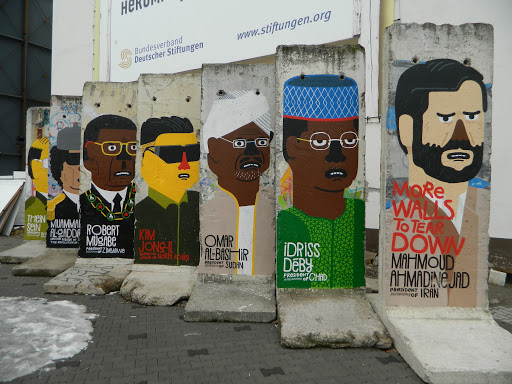In the city by 9.30am and, passing the expensive fashion shops on Friedrichstrasse, we headed down to the Mauermuseum at Checkpoint Charlie, dodging Japanese and American tourists queuing to have their pictures taken with young German men dressed up as American, Russian and GDR soldiers. A bit tacky!

Mauermuseum detailed in extensive description the lives of the residents of the GDR and the desperate attempts that many of them made to cross the wall to the West.
It housed the fragile and eye-wateringly daring means of escapes of those who survived the crossing which included the hot air balloon we both remembered from the 1980s, on which two families flew over the Wall. Other items included home-made zip wire harnesses, converted canoes and a cement-filled panelled car (to make it bullet proof).

Our next stop was Stasi, a free exhibition which presents the concept of a surveillance state and the ways and means in which it infiltrates everyday life. Millions of documents with innocuous details of every day life were ‘rescued’ by Berliners on the peaceful dissolution of the Stasi in 1989. The records also provide clues as to the fate of the many thousands of missing East Germans.
Trabiworld next door was a light-hearted display of many coloured Trabants, the car we had enjoyed seeing very much alive on the streets of Budapest two years ago. In Berlin they form a colourful convoy of tourists paying to drive a few blocks for the fun of it.
The free and informative Typography of Terrors exhibition is housed on the site of the flattened Gestapo headquarters on Willhelmstrasse, which is chillingly also home to a standing section of the Wall built on top of the Gestapo’s previous torture cellars. The exhibition detailed with extraordinary archive photography the rise of the Nazis and featured as its central character not Hitler, but Himmler.
The archive showed his creation and control of the terrors of the Reich – Gestapo, SS and Waaffen SS. Sinister, chilling and disturbing it boldly confronted us with the realities of the worst of all possible nightmares.

After a stroll around the futuristic Potsdamer Platz, a heart-warming Kartoffelsuppe set us up for the afternoon and a walk through the iconic Brandenburg Gate. A carnival of dressed up characters posed for pictures in the noisy throng of coach parties and street artists.

We walked on to the Reichstag seeing the same steps that jack-booted Hitler and his henchman strode up eighty years ago, and almost got ourselves waved through to the Bundestag. A genuine mistake which demonstrated the surprisingly relaxed security.

A Saturday early evening beer beckoned in Berlin’s oldest quarter, Nikolaiveirtel. Selecting a chandelier and candle-lit bar just behind the Spree we admired the tall merchant houses and elegant street lights illuminating the falling snow before heading wearily back on the u-bahn.


